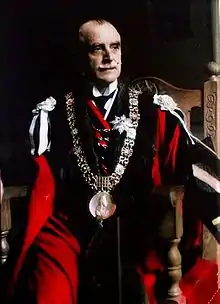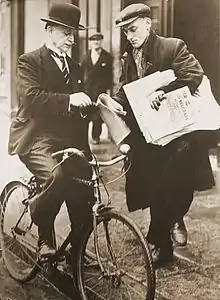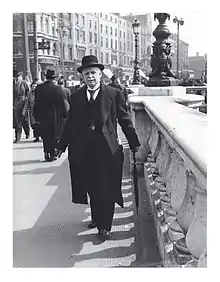Alfie Byrne | |
|---|---|
 Byrne in his mayoral robes | |
| Teachta Dála | |
| In office July 1937 – 13 March 1956 | |
| Constituency | Dublin North-East |
| In office February 1932 – July 1937 | |
| In office August 1923 – December 1928 | |
| Constituency | Dublin North |
| In office June 1922 – August 1923 | |
| Constituency | Dublin Mid |
| Lord Mayor of Dublin | |
| In office June 1954 – May 1955 | |
| Preceded by | Bernard Butler |
| Succeeded by | Denis Larkin |
| In office June 1930 – June 1939 | |
| Preceded by | Laurence O'Neill (1924) |
| Succeeded by | Kathleen Clarke |
| Senator | |
| In office December 1928 – December 1931 | |
| Member of Parliament | |
| In office October 1915 – December 1918 | |
| Constituency | Dublin Harbour |
| Personal details | |
| Born | Alfred Byrne 17 March 1882 Dublin, Ireland |
| Died | 13 March 1956 (aged 73) Dublin, Ireland |
| Political party | Independent |
| Other political affiliations | Irish Parliamentary Party |
| Spouse | Elizabeth Heagney |
| Children | 8, including Patrick, A. P. and Thomas[1][2][3] |
Alfred Byrne (17 March 1882 – 13 March 1956) was an Irish politician who served as a Member of Parliament (MP), as a Teachta Dála (TD) and as Lord Mayor of Dublin. He was known as the "Shaking Hand of Dublin".[4]
Early life
The second of seven children, he was the son of Thomas Byrne, an engineer, and Fanny Dowman.[5] His childhood home was at 36 Seville Place, a terraced house with five rooms just off the North Strand in Dublin.[6] Byrne dropped out of school at the age of 13, and was soon juggling jobs as a grocer's assistant and a bicycle mechanic.[7] Eventually he used his savings to buy a pub on Talbot Street.[7] He married Elizabeth Heagney in 1910.[8]
Early political career

Byrne became an Alderman on Dublin Corporation in 1914. He was a member of the Dublin Port and Docks Board, a significant position for a politician from the Dublin Harbour constituency. In the records of the Oireachtas his occupation is given as company director. He was elected as MP for Dublin Harbour in a by-election on 1 October 1915, following the death of William Abraham, as a candidate of the Irish Parliamentary Party.[9] The Easter Rising in 1916 was followed by the rapid decline of the Irish Parliamentary Party and the rise of Sinn Féin. At the general election in 1918 Byrne was defeated by a Sinn Féin candidate, Philip Shanahan.
Byrne was elected as an Independent TD supporting the Anglo-Irish Treaty for the Dublin Mid constituency at the general election to the Third Dáil in 1922.[7][10] From 1923 to 1928 he represented Dublin North. He was an elected member of Seanad Éireann, for a six-year term from 1928. He vacated his Dáil seat on 4 December 1928. He resigned from the Seanad on 10 December 1931, and returned to the Dáil in 1932. He remained a TD until his death in 1956, representing Dublin North (1932–1937) and Dublin North-East (1937–1956).[11] In several elections he secured more votes than any other politician in the country.[12]
Lord Mayor (1930–1939)

Byrne was elected as Lord Mayor of Dublin in 1930,[13][14] serving in the post for nine consecutive years.[15] When cycling or walking around the city he dispensed lollipops to children, who were often seen chasing him down the street. With a handshake and a few words for all, his eternal canvassing soon earned him the first of his nicknames: the Shaking Hand of Dublin.[6] Married with eight children, Byrne treated the people of Dublin as his second family.[16] Every morning he would find up to fifty people waiting for him in the Mansion House. None had appointments. All were met. Byrne answered 15,000 letters in his first year as Lord Mayor.[17] Many were from Dubliners looking for a job, a house, some advice or a reference. One morning in 1931 a journalist watched the Lord Mayor attend to his correspondence. Within an hour he accepted "seventeen invitations to public dinners, one invitation to a public entertainment and eight invitations to public functions." Then he dictated forty-three sympathetic letters to men and women looking for employment.[17] In 1937, children between the ages of eight and eleven years old were being sentenced to spend up to five years in Industrial Schools. Their crime was stealing a few apples from an orchard. When Byrne said such sentences were "savage," a judge responded with a defence of the Industrial School system, urging an end to "ridiculous Mansion House mummery."[18] Byrne stood firm: "For the punishment of trifling offences the home of the children is better than any institution."[19] In 1938, Byrne was favoured by the press for the presidency of Ireland, a ceremonial role created in the new Constitution, but he was outgunned by the political establishment.[20]
Relations with the United States and the United Kingdom

When, in 1935, Byrne became the first Lord Mayor of Dublin to visit North America in 40 years, he was granted the freedom of Toronto, and The New York Times hailed the arrival of a "champion showman."[6] Byrne often extended a hand of friendship to Britain. He also improved relations between Dublin (until recently the centre of British authority) and the rest of the country. One night Dublin Fire Brigade got an urgent call for assistance from Clones.[21] As Lord Mayor, Byrne felt obliged to join the men on top of the fire engine as they set off on the 85-mile journey in the middle of the night.[22]
Anti-communist connections
In August 1936, Byrne addressed the inaugural meeting of the anti-communist Irish Christian Front, some of whose members later expressed anti-Semitic views.[23] In 1938, as Lord Mayor, he presented a gift of a replica of the Ardagh Chalice to Italian naval cadets visiting Dublin on board two warships, who had been welcomed by the Irish government despite the protests of Dubliners.[24] A photograph exists of Byrne giving a fascist salute along with Eoin O'Duffy, commander of the Blueshirts, around 1933.[25]
Final term as Lord Mayor (1954)
In 1954, Byrne was elected as Lord Mayor for a record tenth time. This time he did not live in the Mansion House, but stayed in Rathmines with his family, taking the bus to work each morning.[26] He was just as devoted to the job. When flooding damaged 20,000 houses in Fairview and North Strand, he rose from his sick bed to organise a relief fund.[26] Byrne's final term as Lord Mayor came to an end in 1955. Shortly afterwards, Trinity College Dublin awarded him an honorary Doctorate of Law, describing him as a "champion of the poor and needy, and a friend of all men."[27]
Death
Alfie Byrne died on 13 March 1956. An obituary in The Irish Times noted:[7]
For more than forty years, he was a prominent figure in public life, serving his country and city with a rare and single-minded devotion. Himself a true Dubliner, he had a profound understanding of, and deep sympathy for, the needs and interests of his fellow-citizens, especially the poor. It is not too much to say that he lived for them, for wherever there was distress, he was promptly on the spot to ensure that assistance was made available with the utmost speed.
Byrne's funeral was the largest seen in Dublin for many years. The Evening Herald reported that "Traffic in O'Connell Street was held up for almost 20 minutes to allow the cortege of over 150 motor cars to pass, and at all the junctions along the route to Glasnevin people silently gathered to pay tribute to one of Dublin’s most famous sons".[28] The Irish Times noted that "one of the largest groups of people gathered at the Five Lamps, one of the few places at which Alderman Byrne always made a speech during his election campaign for Dublin North-East."[7] The Irish Press reported a tribute by the Taoiseach, John A Costello, "He had great personal charm and was known for his old-world courtliness both at home and abroad.... We mourn in the passing of Alfie Byrne the loss of an honoured and distinguished Irishman whose place in the hearts of his fellow countrymen was unique and who gave a lifetime of unselfish devotion to their service."[7] The members of the Dáil stood and observed a short silence as a mark of respect. A telegram was sent to his widow from the Mayor of New York, Robert F. Wagner Jr., expressing deepest sympathy, and stating "that Ald. Byrne had attained high office of Lord Mayor many times, but he never lost contact with the poor and the underprivileged, whose champion he was".[29]
Legacy
The press called him the "Shaking Hand of Dublin",[4] Alfred the Great,[30] and The Lord Mayor of Ireland, but most people knew him simply as Alfie.[31] As one of the most popular Dublin-born politicians of the 20th century, he did not write a memoir.[12] The by-election caused by his death, was won by his son Patrick Byrne. Two other sons A. P. Byrne and Thomas Byrne were also TDs for various Dublin constituencies. Alfie Byrne Road in Clontarf is named after him.[32] The Dublin Bay North branch of Young Fine Gael was renamed 'Alfie Byrne YFG'.[33]
Alfie Byrne also holds the distinction of being the only person to serve as Councillor, Alderman, Lord Mayor of Dublin, MP, TD and Senator.
See also
References
- ↑ "Bolger, Carmel: Death notice". Irish Times. 2 January 2014. Archived from the original on 16 June 2017. Retrieved 14 October 2017.
- ↑ "Perrott: Death notice". Irish Times. 15 August 2005. Archived from the original on 14 June 2017. Retrieved 14 October 2017.
- ↑ "New arrival at the Mansion House!". Dublin City Council. February 2013. Archived from the original on 21 October 2017. Retrieved 21 October 2017.
- 1 2 Frank McNally (6 June 2015). "The Darling of Dublin - An Irishman's Diary about Alfie Byrne". The Irish Times. Archived from the original on 19 July 2015. Retrieved 29 July 2015.
- ↑ "General Registrar's Office". IrishGenealogy.ie. Retrieved 17 March 2017.
- 1 2 3 Niall Curran (2015). "Alfie Byrne: Dublin's Longest-Serving Lord Mayor and Champion of the Poor". Soundcloud. Dublin City FM. Archived from the original on 4 March 2016. Retrieved 29 July 2015.
- 1 2 3 4 5 6 "Death of Alderman Alfred Byrne: 'Much-Loved Friend of the Poor'". The Irish Times archive. 14 March 1956. Retrieved 28 July 2015.
- ↑ "General Registrar's Office". Irishgenealogy.ie. Retrieved 19 October 2017.
- ↑ "Alderman Byrne Returned". The Irish Times archive. 9 October 1915. Retrieved 28 July 2015.
- ↑ "Alfred Byrne". Oireachtas Members Database. Archived from the original on 6 July 2018. Retrieved 11 April 2012.
- ↑ "Alfred Byrne". ElectionsIreland.org. Archived from the original on 12 April 2012. Retrieved 11 April 2012.
- 1 2 Dolan, Anne. "Byrne, Alfred". Dictionary of Irish Biography. Retrieved 5 February 2022.
- ↑ "Lord Mayors of Dublin 1665–2020" (PDF). Dublin City Council. June 2020. Retrieved 18 November 2023.
- ↑ "Greater Dublin: The Three New Councils". Weekly Irish Times. 11 October 1930. Retrieved 28 July 2015.
- ↑ "He Was Lord Mayor of Dublin Ten Times and Friend to All". Irish Pictorial. 24 March 1956. Retrieved 28 July 2015.
- ↑ "Tribute Paid to Alderman Byrne at Service". The Irish Times archive. 19 March 1956. Retrieved 28 July 2015.
- 1 2 "Busiest Man in Ireland". The People. 1 February 1931.
- ↑ "Justices Will Probe Lord Mayor's 'Savage Sentences' Allegations". Daily Express. 23 October 1937.
- ↑ "Lord Mayor's Reply to Criticism of Speech: Courts and Children". The Irish Press. 7 April 1937.
- ↑ "£15,000 a year". Evening Standard (London). 8 April 1938.
- ↑ "Lord Mayor of Dublin Cheered at Clones". The Weekly Irish Times. 23 October 1937.
- ↑ Matt Cooper. "The Last Word with Matt Cooper". Today FM. Archived from the original on 4 March 2016. Retrieved 29 July 2015.
- ↑ Donal Fallon (17 December 2014). "All's Loud On The Christian Front". Come here to me!. Archived from the original on 8 July 2015. Retrieved 7 July 2015.
- ↑ Donal Fallon (July 1938). "Fascist Warships in Dublin Bay". Come here to me!. Archived from the original on 8 July 2015. Retrieved 7 July 2015.
- ↑ Irish fascist leader Eoin O'Duffy at a rally of his Blueshirts. To his right is Alfred Byrne, the Lord Mayor of Dublin Archived 8 July 2015 at the Wayback Machine, Getty Images.
- 1 2 David McEllin. "Legendary Lord Mayor Alfie Byrne". In Leaders of the City: Dublin’s First Citizen, 1500–1950, ed. by Ruth McManus & Lisa-Marie Griffith, (Dublin: Four Courts Press, 2013), 163.
- ↑ "Honorary degree for Ald. Byrne". Dublin Evening Mail. 5 July 1955.
- ↑ "Alfie Byrne Obituary". The Evening Herald. 15 March 1956. Retrieved 29 July 2015.
- ↑ "Alfie Byrne Obituary". The Irish Press. 15 March 1956. Retrieved 28 July 2015.
- ↑ "Alfred the Great" Dublin Opinion 9, no 105 (November 1930).
- ↑ "Lord Mayor’s Postbag: 15,000 Letters". The Irish Times. 13 February 1931.
- ↑ "Alfie Byrne memorial bench to be removed after being targeted by vandals". Irish Independent. 18 May 2015.
- ↑ Varadkar, Leo (9 October 2017). "'Shaking Hand of Dublin' who inspired us all". Irish Independent.
Further reading
- Who's Who of British Members of Parliament: Vol. II 1886-1918, edited by M. Stenton & S. Lees (The Harvester Press 1978)